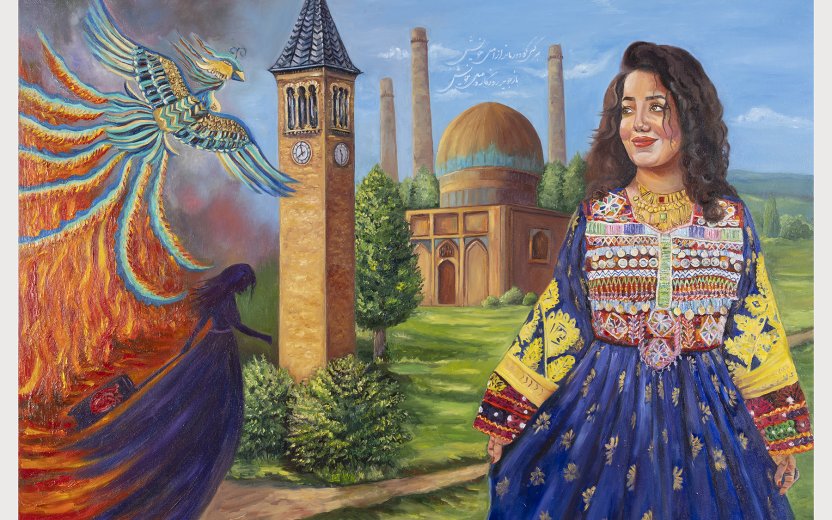Elja Sharifi: From Herat to Cornell
Artist Statement
From Herat to Cornell speaks of the resilience of women, especially Afghan women. I am part of a vast collective narrative, one voice among thousands who have endured pain, struggled, and stood firm.
A Portrait of Resistance
In this painting, I have portrayed myself, a woman, with a story of resistance. The figure stands on the right side of the composition, dressed in a traditional Afghan gown that symbolizes identity and culture, an expression of love for my homeland and its values. The patterns on the dress are hand-stitched, adorned with coins from different Afghan dynasties; the older the coins, the greater the garment’s value and history.
The color of the dress is lapis blue, a hue derived from the lapis-lazuli stones of Badakhshan, a color that has held deep significance in Afghan art throughout history, particularly during the Timurid period (1370–1507). The woman’s slight smile conveys confidence and dignity, yet also a quiet sorrow. I deliberately painted her lips red—a reference to the symbolic protest campaign known as “Red for Afghanistan Women” launched in March 2025, by Afghan women inside and outside the country in defiance of Taliban oppression. In the painting, red lipstick becomes a symbol of choice, courage, identity, and resistance—a reminder that, throughout history and even under tyranny, Afghan women have never surrendered and continue to fight against the darkness.
Red lipstick becomes a symbol of choice, courage, identity, and resistance—a reminder that, throughout history and even under tyranny, Afghan women have never surrendered.
The woman gazes toward the path, the past, and the shadow of another woman pulling a suitcase, as a simurgh descends toward her from the upper left. That shadowed woman represents my past self, a time when I felt weightless and invisible, stripped of everything: family, work, homeland, and a sense of belonging. I had packed my entire life into a single suitcase and carried with me a heart heavy with grief, its fragmented pieces reflecting the magnitude of my sorrow.
From Flames to Renewal
The left side of the composition burns in flames, the sky above it filled with smoke, the fire of war, which has consumed Afghanistan for decades. Like so many of my generation, I was not spared from its devastation. Only months before I left the country, I witnessed the brutal clashes between government and Taliban forces, memories that will remain with me forever. Yet, at the height of despair, a new path opened before me when I was accepted by Cornell. It was as if life began to regain color, transforming grief into renewal. The once-gray tones of fire and ash gradually gave way to shades of green, symbolizing the return of life.
From the upper left, the simurgh appears in luminous hues of lapis and turquoise. In Persian mythology, the simurgh is a legendary bird, a guardian of wisdom and a symbol of divine presence.
The simurgh plays a central role in Persian epic and mystical literature. In Firdawsi’s Shahnameh, her nest rests upon the mythical Mount Qaaf. She is wise and all-knowing, a guardian of hidden truths. It is the simurgh who raises Zal, the father of the hero Rostam, sheltering him under her wings and guiding him with compassion. The bird also appears in the writings of the poet Attar, particularly in The Conference of the Birds (Mantiq al-Tayr), where the flock of 30 birds sets out in search of the simurgh, only to discover at the journey’s end that the divine presence they seek resides within themselves. The simurgh thus becomes a symbol of divine wisdom, embodying God’s eternal truth.
The simurgh can represent the human self, the individual who, through the pursuit of knowledge, awareness, and perseverance, becomes a source of light and resilience. In that sense, I too, can become the simurgh.
Here, the simurgh signifies that higher force, a divine presence that I believe has always guided and protected me through moments of hardship, solitude, and uncertainty, illuminating my path with infinite wisdom. Yet, like in Attar’s allegory, the simurgh can also represent the human self, the individual who, through the pursuit of knowledge, awareness, and perseverance, becomes a source of light and resilience. In that sense, I too, can become the simurgh.
In this new chapter of my life, the simurgh heralds enlightenment and renewal. My acceptance into the PhD program at Cornell marked one of my greatest dreams realized, a rebirth after loss. The bird, both guardian and messenger of knowledge, flies joyfully toward the woman in the painting to bestow upon her these gifts.
Just as Afghan women continue to rise from the ruins of oppression, each one of them is a phoenix, carrying within her the fire of endurance and the strength to begin anew.
At the same time, the bird can be a phoenix, a universal emblem of immortality, sacrifice, and rebirth through fire. I feel that my arrival at Cornell and the fulfillment of my academic dreams revived me from the ashes of a painful past. And just as Afghan women continue to rise from the ruins of oppression, each one of them, too, is a phoenix, carrying within her the fire of endurance and the strength to begin anew. The sky on the left remains stormy and gray, yet within it glimmers the promise of transformation.
Two Cities, One Vision
At the center lies a lush, radiant city, Herat, my beloved birthplace, and Cornell, the place where I was reborn and where life began anew. Cornell has become my second home: a safe haven filled with kind and supportive people who have taken the place of family, and a space where distant dreams have found their form. I wanted to unite both Herat and Cornell within a single image—to build my own utopia, a meeting point between memory and renewal.
On the right stands the dome of Gawharshad Begum’s mausoleum in Herat. Queen Gawharshad was a noblewoman and political leader of the Timurid dynasty, a woman of immense power, generosity, intellect, and vision. As the wife of Sultan Shahrukh, who ruled Herat for 43 years, she became one of the most influential patrons of art and culture in the 15th century. Under her guidance, the Persian language flourished at the Timurid court, and through her patronage of artists, architects, philosophers, and poets, she helped spark a cultural renaissance in Herat.
The dome, part of the Musalla Complex of Herat, was commissioned by Gawharshad and remains one of the city’s most significant monuments. Originally composed of 10 minarets, only five survive today, standing as enduring symbols of the city’s artistic and historical resilience.
Gawharshad has always represented, for me, the image of a wise woman—a steadfast patron of art, culture, and intellect. As a woman, I associate Herat with her name, and for that reason, depicted her dome as a feminine symbol of the city. Herat is where I formed my identity, a city I carry with me wherever I go, and one that I love deeply, regardless of geography or circumstance.
Cornell became the bridge that led me back to my true self. Through knowledge, art, and learning, I have returned to my essence in another land.
McGraw Tower represents Cornell University, a place that sheltered and supported me through the darkest moments of my life, and where my work, study, and aspirations have found new meaning. Interestingly, the idea for McGraw Tower was proposed by a woman, Jennie McGraw, in 1868—much like the dome and the Musalla Complex of Herat were envisioned and commissioned by a woman, Gawharshad Begum.
Above the dome, I inscribed a verse by the great 13th-century Persian poet Rumi, written in shekasteh (cursive Persian script). Rumi’s Masnavi-ye Ma’navi is one of the most revered masterpieces of Persian mystical poetry. The verse comes from the Song of the Reed (Nay-nāmeh), the opening 18 lines of the Masnavi:
“Whoever remains far from where they belong,
should seek the day of reunion again”
This verse speaks of the human longing to reunite with one’s true essence, the eternal search for home, belonging, and inner peace. To me, that essence is my homeland, my identity, and my culture, all of which I was forced to leave behind. Yet Cornell became the bridge that led me back to my true self. Through knowledge, art, and learning, I have returned to my essence in another land, continuing my purpose in a new form.
The Path Continues
Now, the sky is calm and blue, and the earth is green once again, yet the path continues—even behind the woman in the painting. I will not surrender. I will keep walking, with the dream that one day, like Gawharshad Begum and Jennie McGraw, my name too will endure—a woman remembered in the history of Afghan art. What I have today is the reward of persistence, struggle, and the boundless support of Cornell, the place that gave me the strength to begin anew.
I believe that as long as Afghan women continue to create, to write, and to dream, no fire will ever be able to silence them.
In this work, I have portrayed not only my own story but also the stories of countless unnamed and unheard women. The painting is a reminder of rebirth, a rise from the ashes of pain to the flight of hope. It weaves together my two homes, Herat and Cornell, and stands as a testament to the truth that wherever women exist, they are the source of resilience. I believe that as long as Afghan women continue to create, to write, and to dream, no fire will ever be able to silence them.



